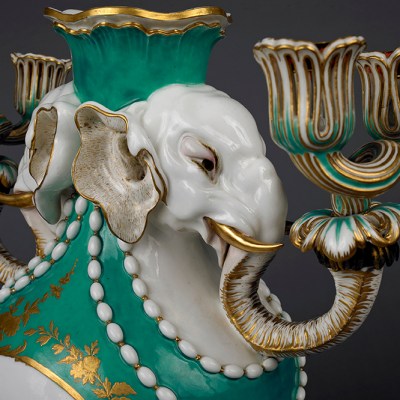‘The Marquise de Pompadour is to appear at Marly in a gown trimmed with English lace that cost 22,500 livres!’ exclaimed the marquis d’Argenson in horror in May 1751. D’Argenson was no fan of the marquise, who dominated court for 20 years as the official mistress to Louis XV. However Jeanne Antoinette Poisson – the title ‘Pompadour’, awarded in 1745, was unique and expired on her death – was a frequent focus of 18th-century anxieties about consumption. Hailing from an arriviste family whose money had come from selling provisions to the army, she brought her enthusiasm for spending and consumer novelties with her to Versailles. Though it is believed her physical love affair with the king lasted only between 1745–50, she achieved and maintained significant cultural and political influence: d’Argenson frequently grumbled that, to all intents and purposes, she was France’s prime minister.
Pompadour at Her Toilette (1750 with later additions), François Boucher. Harvard Art Museums/Fogg Museum

Consumption is a major feature of François Boucher’s portrait of Pompadour at Her Toilette (1750, with later additions), the subject of this zippy, focused volume of four essays, by A. Cassandra Albinson, Mark Ledbury, Gabriella Szalay and Oliver Wunsch. In perhaps the first portrait in Western art to show its sitter applying cosmetics, the marquise looks up from her mirror and directly at the viewer. She has already whitened her face from the elegant gold powder case on the table in front of her, using a frothy feather powder-puff (houppe), and is painting her cheeks with a brosse à rouge, an 18th-century innovation that allowed for the more precise application of colour. The rouge itself is probably imported: from the 16th century onwards, locally available alkanet dyes and iron oxides were increasingly replaced in the European cosmetics trade by Pernambuco wood (from Brazil), sandalwood (from South East Asia) and (from Mexico and Central America) the vibrant but fabulously expensive cochineal. As such, throughout the 18th century, rouge formed an integral part of the ‘triangular trade’ of ships carrying consumer goods and enslaved Africans, highlighting (as Wunsch points out) the variety of ways it was possible to manufacture and package skin. Pompadour had at least two slave ships named in her honour.
Madame de Pompadour: Painted Pink arose from a planned exhibition at Harvard Art Museums on the colour pink across 18th- and 19th- century European art. The exhibition’s fate was sealed when it was scheduled for 2020–21 and so, instead, the book looks in depth at Boucher’s painting of the pink-cheeked marquise. This is one of 11 surviving portraits of Pompadour, and the only one to refer explicitly to her relationship with Louis XV, whose profile appears in a cameo on her wrist. The result is a rewardingly detailed discussion of the painting, building cumulatively from Albinson’s discussion of sensibility and motherhood (the marquise’s daughter, Alexandrine, died in 1754 at the age of 10) to Wunsch’s discussion of race, via Mark Ledbury on shells and Gabrielle Szalay on porcelain. Though the conceit of thinking specifically about pink is arguably a twist too far, it does offer an intriguing lens on Boucher, whose characteristic use of the colour has divided critics. While, for the Goncourt brothers – among the most passionate of the rococo’s 19th-century devotees – Boucher’s pink was ‘tender and pale like a rain-soaked rose’, their contemporary Arsène Houssaye spuriously accused the artist of having said that ‘he found nature extremely disagreeable, too green and badly lit’. Boucher’s apparent preference for pink over green signalled his imperviousness to the rugged beauty of the real countryside, through which Houssaye imagined the painter searching, in despair, for Pan and Narcissus.
Pompadour at Her Toilette (detail; 1750 with later additions), Harvard Art Museums/Fogg Museum

This tension between the natural and the artificial is similarly central to Pompadour at her Toilette, where the use of make-up calls attention to the continuity between the painting of portraits and of faces. Contra Houssaye, Ledbury makes a convincing case for Boucher’s interest in the natural world, at least if we turn from the fields to the seas. His essay traces marine imagery in the pearl pinheads on the marquise’s chair, the ‘spongiform body’ of the powder puff, and the distinctive ‘shell pink’ of the cameo. Szalay suggests that the flowers on the table, on the other hand, are distinctly artificial, perhaps originating from the porcelain factory at Vincennes, of which Pompadour was an enthusiastic patron. In 1750, d’Argenson had also been appalled to learn that Louis XV had ordered porcelain flowers from Vincennes ‘painted like natural ones, in vases’ at a cost of 800,000 livres. During the same period, the factory was developing the fond rose that would become its hallmark (popularly, if erroneously, dubbed rose Pompadour).
Tray (1757–58), painted by André-Vincent Viellard and manufactured by the Sèvres Manufactory. Wadsworth Atheneum Museum of Art, Hartford, Connecticut

While formally modest in scope and scale, Madame de Pompadour: Painted Pink is a surprisingly wide-ranging collection, backed up by an abundance of footnotes – in neon pink – and lavish illustrations, including a generous sequence of enlarged details. Though it would be fascinating to expand some of the issues raised to the scale of the original exhibition, the project as presented is a welcome reminder of the pleasure, and value, of slow, close looking.
Madame de Pompadour: Painted Pink by A. Cassandra Albinson (ed.) is published by Harvard Art Museums.



